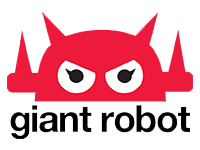Giant Robot Store and GR2 News
Perhaps this image has come across your social media feeds, if not, please share it now. Lots of people get leukemia, but some have it harder than others to find bone marrow matches. The NY Daily News did a story on Leni and a Korean American mother who are in leukemia limbo. Read and share, and spread the word about how simple it can be to improve the odds for minorities and mixed-race people in a very unfair fight. Leukemia has already touched the GR family. In the memory of Janet Liang, and so many others who fought bravely and worked to educate about the importance of becoming a possible donor, please attend the bone marrow drives or fundraising efforts being organized by friends and family of Leni Hsiao. West Coast events are coming soon. • Love for Leni Pizza September 1, 2013 – October 1, 2013 Speedy Romeo (376 Classon Ave., Brooklyn, NY 11238) In honor of Leni and her fight against cancer, Speedy’s amazin g owners are donating $5 from every Margherita pizza sold in September to t he #loveforleni fund!! • Swab for Leni September 14, 2013 at 12:00 pm – 4:00 pm Carriage House Birth (97 North 7th St., Brooklyn, NY 11249) A Fundraiser and Bone Marrow Drive to support LoveforLeni • #LoveforLeni Bone Marrow Drive September 21, 2013 at 1:00 pm – 5:00 pm Reed Annex – 151 Orchard Street, New York 10002 • Leukemia & Lymphoma Society’s Light the Night Walk September 25, 2013 at 5:30 pm – 8:30 pm Pier 57, New York, NY http://pages.lightthenight.org/nyc/Manhattn13/LoveforLeni#home • #LoveforLeni Art Fundraiser October 8, 2013 at 7:00 pm – 9:00 pm Reed Space – 151 Orchard Street, New York 10002 Like LoveforLeni on Facebook to stay updated on events around the country, and share her story not just for her, but for the others struggling to find a match.
Continue reading
Perhaps this image has come across your social media feeds, if not, please share it now. Lots of people get leukemia, but some have it harder than others to find bone marrow matches. The NY Daily News did a story on Leni and a Korean American mother who are in leukemia limbo. Read and share, and spread the word about how simple it can be to improve the odds for minorities and mixed-race people in a very unfair fight. Leukemia has already touched the GR family. In the memory of Janet Liang, and so many others who fought bravely and worked to educate about the importance of becoming a possible donor, please attend the bone marrow drives or fundraising efforts being organized by friends and family of Leni Hsiao. West Coast events are coming soon. • Love for Leni Pizza September 1, 2013 – October 1, 2013 Speedy Romeo (376 Classon Ave., Brooklyn, NY 11238) In honor of Leni and her fight against cancer, Speedy’s amazin g owners are donating $5 from every Margherita pizza sold in September to t he #loveforleni fund!! • Swab for Leni September 14, 2013 at 12:00 pm – 4:00 pm Carriage House Birth (97 North 7th St., Brooklyn, NY 11249) A Fundraiser and Bone Marrow Drive to support LoveforLeni • #LoveforLeni Bone Marrow Drive September 21, 2013 at 1:00 pm – 5:00 pm Reed Annex – 151 Orchard Street, New York 10002 • Leukemia & Lymphoma Society’s Light the Night Walk September 25, 2013 at 5:30 pm – 8:30 pm Pier 57, New York, NY http://pages.lightthenight.org/nyc/Manhattn13/LoveforLeni#home • #LoveforLeni Art Fundraiser October 8, 2013 at 7:00 pm – 9:00 pm Reed Space – 151 Orchard Street, New York 10002 Like LoveforLeni on Facebook to stay updated on events around the country, and share her story not just for her, but for the others struggling to find a match.
Continue reading
Asia is changing. I wrote previously that Japan’s ethnic sociology is shifting. However, Japan isn’t the only country in Asia coping with evolving demographics. According to a recent article from The Diplomat, South Korea is finally acknowledging the permanent settlement of foreigners, international marriages, and their children. This is just one of the many sociological issues that South Korea shares with its continental cousin. The other is the ethno-nationalism that persists in both countries. This blood-based nationalism has, as the article suggests, restricted South Korea from sublimating its definition for what it means to be Korean in the 21st century. What the article overlooks is that this race-based brand of politics is directly related to one of its historical enemy. Scholars and commentators like B.R. Myers have argued that the myth of Korean exceptionalism traces back to Japan’s annexation of Korea. According to Myers, the concept of tanil minjok (단일 민족) didn’t appear until the Japanese brought it to Korea. The Japanese implemented a European inspired brand of race theory to co-opt a developing nationality ensuing in reaction to the Japanese occupation. Except in this instance, the Japanese occupation taught Koreans that they were both of the same “Yamato race.” The only difference, in the eyes of the occupation, is that the Japanese saw most ‘Koreans’ as subordinate due to distinctions of class according to Sociologist John Lie’s book, Multiethnic Japan. What came about is the ethno-nationalism that people see today. The reason why I bring up the shared historical ideologies of Korea and Japan is because, as I stated earlier, both countries are facing shifting demographics. The days in which someone who is born in Japan is always of “100%” Japanese are long gone. The myth of homogeneity in Japan and its discriminatory practices against foreigners is the recurrent narrative in The Land of the Rising Sun. A similar type of story is surfacing where non-Koreans and their biracial inhabitants face identical prejudices. Furthermore, Japan’s reluctance to tackle these issues could offer a framework for what South Korea should avoid. So far, I’m under the opinion that the Japanese government has done little to ameliorate the problems their immigrants face. In certain instances, some of the comments from their various Prime Ministers and politicians have done more exacerbate sentiments against its multi-ethnic residents. (See Taro Aso and Ishihara Shintaro). Similarities aside, the stark difference between the two nations is that South Korea seems to be taking the issue seriously. The only education based multicultural program in Japan that I can recollect at the top of my head is the JET Program and that’s proving to be a bungling failure in its own respect. It’s not just this, but Japanese politicians have been more than stubborn to the U.N.’s calls for legislative reforms on the matter. The creation of a multicultural program catered directly towards its inhabitants is unprecedented in its economic big brothers like China and Japan. Like Japan, China is defensive of its domestic practices. I spoke to Michelle Gamboa,...
Continue reading



